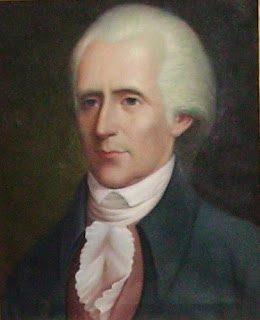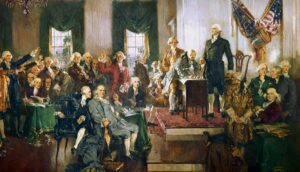
George Read is another founding father that is not widely known and one who became a revolutionary despite himself. Representing Delaware, he favored reconciliation with the Crown rather than independence. He had signed the Petition to the King in 1774 but voted against the Declaration of Independence in 1776. He did, however, sign the Declaration, and later the Constitution being one of only two who signed all three of these documents. Once independence became the cause of the colonies, Read embraced the movement and served in both federal and state positions for most of the rest of his life. He was truly a patriot and reluctant hero.
The eldest of six sons of John and Mary (Howell) Read, George Read was born on 18 September 1733 in Cecil County, Maryland. John Read was a prosperous planter and developer in Maryland and Delaware. He also was one of the founders of Charlestown, Maryland. Soon after George’s birth, the family relocated to a large plantation at Christiana, Delaware near New Castle.
George attended exclusive schools in Pennsylvania and at the age of 15 began reading law with John Moland in Philadelphia. He was admitted to the Philadelphia Bar in 1753. At this point, George Read showed great generosity to his siblings. As the eldest son of John Read, he was entitled to two shares of his father’s estate, but he gave up his inheritance by transferring it to his brothers. He explained that his education was his proper portion. George Read was known for generosity, dignity, and kindness throughout his life.
In 1754 George set up his own law practice in New Castle and rapidly became a successful and respected attorney with clients in both Delaware and Maryland. In 1763 he married Gertrude Ross Till. She was the daughter of Reverend George Ross, Rector of Immanuel Episcopal Church, and the widowed sister of George Ross who like Read was a future signer of the Declaration of Independence. The union of George and Gertrude produced four sons and one daughter.
Read was appointed Crown Attorney General for three Delaware counties in 1763. In 1765 he began service in the Delaware Colonial Legislature. Despite his apparent loyalty to the Crown, he was opposed to the new British taxes and other provocative actions. This led to his joining, and leading the resistance group, the Delaware Committee of Correspondence. He became active in the patriot movement, but he continued to strongly advocate for reconciliation with the Crown. In 1774 George Read was elected as a Delaware representative to the first and second Continental Congresses.
In the 18th century, the Colony of Delaware was divided into two loose factions, the “Court Party” and the “Country Party.” The Court Party was the majority. It was generally Anglican, worked well with the colonial government, and favored reconciliation with the British. The minority Country Party was mostly Ulster-Scot who hated the British and openly advocated for independence. Read was one of the leaders of the Court Party and worked in opposition to some of his friends and neighbors who were pro-independence.

Read’s attendance during the proceedings of the first and second Continental Congresses was irregular, but when he did attend, he advocated for caution and reconciliation. He was distrustful of what he believed was “extremism” and believed Richard Henry Lee’s resolution for independence to be hasty and ill-advised. He felt the colonies were unprepared for the war that would follow, and his natural inclination was to be cautious and to negotiate.
On 2 July 1776, George Read voted against independence believing reconciliation was still possible. This caused a crisis and a pro-independence Delaware delegate, Ceasor Rodney, had to ride all night to reach Philadelphia to break the stalemate in the state’s delegation. When it was apparent that the Declaration of Independence had wide support, Read signed the document in a show of unity, as Robert Morris of Maryland also did. Both men then embraced the cause of independence and became true supporters of revolution.
Two of George Read’s brothers served in the military. Brother Thomas was an officer in the Continental Navy, and James was an officer in the Continental Army. Revolution was a Read family affair.
Later in 1776, George Read turned his attention to state responsibilities and presided over the Delaware Constitutional Convention. He chaired the drafting committee, which composed the 1776 Delaware Constitution. He also began a term as Speaker of the Legislative Council, which made him vice president of the state.
The British occupied Wilmington, Delaware in the fall of 1776 and captured the president of the state. George Read was in Philadelphia attending the Continental Congress. In November he and his family were nearly captured by the British as they escaped Philadelphia while it was being occupied by the Redcoats. Once safely reaching Dover, Delaware, Read assumed the office of president, a position he held until spring of 1778.
During the Legislative Council of 1779 Read drafted the act directing the Delaware Continental congressional delegates to sign the Articles of Confederation. That same year he had to resign from the council due to poor health and refused reelection to congress. By 1782 he was again on the council, and concurrently served as judge of the Court of Appeals in admiralty cases.
In 1784 Read served on a commission that adjusted New York-Massachusetts land claims. In 1786 he attended the Annapolis Convention (A precursor to the Constitutional Convention). He also was a Delaware delegate to the Constitutional Convention.

At the convention, Read adopted a Hamiltonian stance championing a strong federal government, and a strong executive. He was also very outspoken and concerned about the rights of the smaller states. At one point Read threatened to take the smaller states out of the convention unless their rights were protected in the new Constitution. The new Constitution addressed his concerns, and on 17 September 1787, George Read signed the Constitution of the United States of America. He then led the ratification movement in Delaware, the first state to ratify.
I am including a description of George Read that was done during the Constitutional Convention that is interesting considering he was an effective delegate:
“George Read (Delaware) is a Lawyer and a Judge;–his legal abilities are said to be very great, but his powers of Oratory are fatiguing and tiresome to the last degree;–his voice is feeble, and his articulation so bad that few can have patience to attend to him. He is a very good Man, and bears an amiable character with those who know him. Mr. Read is about 50, of a low stature, and a weak constitution.” — Character Sketches of Delegates to the Federal Convention by William Pierce (1787)

Read was a US Senator from Delaware from 1789 to 1793 where his attendance was again erratic. When he did attend, he was a staunch supporter of President Washington, and aligned himself with the Federalists. He resigned the Senate to accept the position of Chief Justice of Delaware, a position he held until his death on 21 September 1798. George Read was buried in the Immanuel Episcopal Churchyard in New Castle, Delaware.
George Read led a busy life of service to his state and country that began during Colonial times. Although not well known now, he was during his life and he was respected by all who knew him. He was a cautious man, not a “firebrand,” but he actively participated in the birth of our country. He was not a famous general nor a charismatic politician, but he was the kind of man who toiled effectively to build a “more perfect union.” We owe a debt of gratitude to men like George Read who did not seek fame or fortune. He was definitely a patriot and an American hero.
